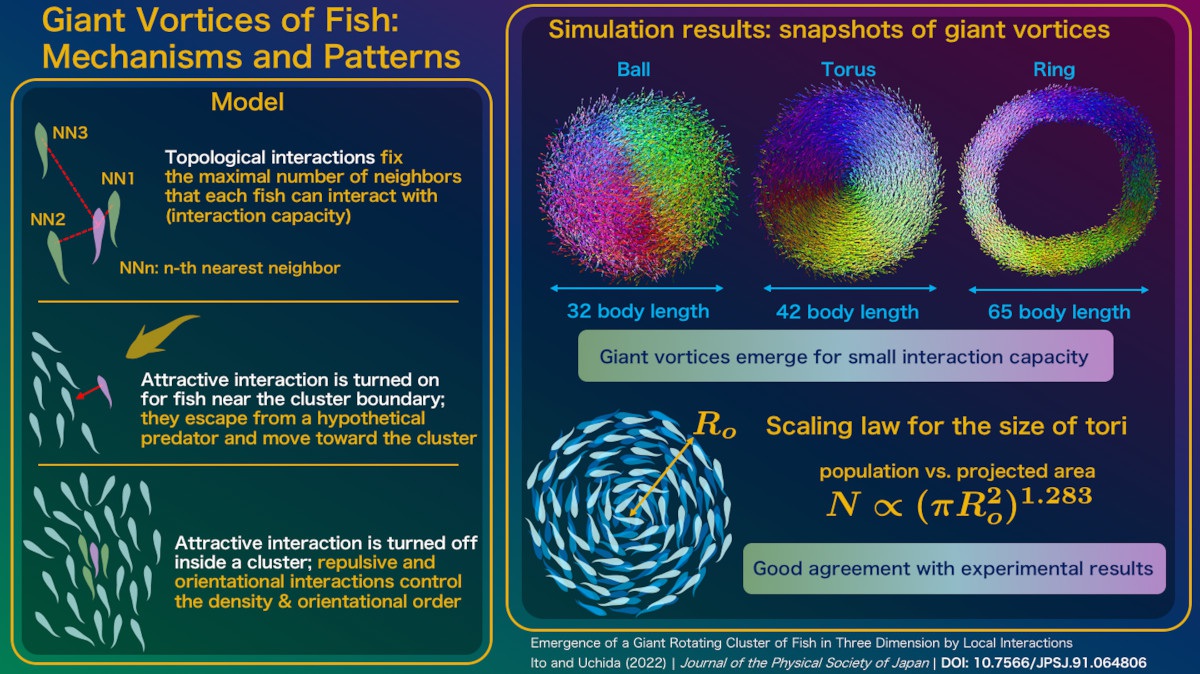Giant Vortices of Fish: Mechanisms and Patterns
© The Physical Society of Japan
This article is on
Emergence of a Giant Rotating Cluster of Fish in Three Dimensions by Local Interactions
(JPSJ Editors' Choice)
J. Phys. Soc. Jpn. 91, 064806 (2022).
The origin of giant rotating clusters of fish is revealed by a new agent-based model that incorporates the topological nature of interactions and the escape response characteristic to fish.

Fish schools form rotating balls, tori, and rings among other collective patterns.These vortex patterns are formed without inherent chirality of individual fish and are therefore considered as an example of spontaneous symmetry breaking due to interactions between self-propelling elements.
Origins of the vortex patterns are previously sought in potential-based attractive interactions, anisotropic interactions via a viewing angle, and/or long-range hydrodynamic interactions. However, several questions have remained on the formation of giant vortices consisting of tens of thousands of fish. For example, previous models require a large portion of fish in a school to interact with each other to form vortex patterns. However, in a high-density school of fish, visual and hydrodynamic interactions are screened, and thousands of fish simultaneously interacting with each other is unlikely. Furthermore, the dependence of the vortex size on the number of fish, which is known to obey a power law in schools of sardines and mackerels, has not been theoretically explained. Finally, three-dimensional rotating balls (known as "bait-balls") have not been reproduced in previous numerical studies.
In the present study, the above-mentioned problems are solved by a new model that incorporates the topological nature of interactions; fish are assumed to interact with up to a certain number of neighbors, which is called the interaction capacity. In addition, the attractive interactions are autonomously controlled such that they are turned on only when the fish has a small number of neighbors in the interaction range. This implies that fish near the cluster boundary are attracted by the cluster, which mimics the escape response characteristic to fish (“fast-start”). The model yields a rich phase diagram of collective patterns consisting of rotating balls, tori, rings, polarized schools, and randomly oriented swarms. The vortex patterns are obtained over a wide range of attraction strength when the interaction capacity is equal to or less than three. The projected area A of a torus scales with the number of fish N according to the power law N∝AV with the exponent ν = 1.283±0.004, which is close to the experimental value of 1.329. (Note that the values lie between 1 for a uniform disk and 3/2 for a uniform sphere.) Each fish in a torus exhibits random walk in the radial direction, instead of rigid-body rotation as predicted by non-topological models. These results indicate that the topological interactions enhance fluctuations in individual motion that trigger spontaneous breaking of the global rotational symmetry.
(Written by S. Ito and N. Uchida)
Emergence of a Giant Rotating Cluster of Fish in Three Dimensions by Local Interactions
(JPSJ Editors' Choice)
J. Phys. Soc. Jpn. 91, 064806 (2022).
Share this topic
Fields
Related Articles
-
Which is Moving?—Pinning Down the Origin of Fluctuations in Muon Spin Relaxation—
Structure and mechanical and thermal properties in condensed matter
Cross-disciplinary physics and related areas of science and technology
2024-3-28
The study demonstrated that we can distinguish between the diffusion motion of the muon itself and the motion of the surrounding ions in muon spin relaxation.
-
Thermodynamic Property of a CMOS Device beyond Landauer Limit
Statistical physics and thermodynamics
Electronic transport in condensed matter
Cross-disciplinary physics and related areas of science and technology
2024-1-23
Focusing on a CMOS NAND GATE operating in a sub-threshold region, the thermodynamic cost of computation was analyzed in relation to input/output voltages surpassing the Landauer limit.
-
Possible Origin of High Thermoelectric Power Factor in Ultrathin FeSe: A Two-band Model
Electronic structure and electrical properties of surfaces and nanostructures
Structure and mechanical and thermal properties in condensed matter
Cross-disciplinary physics and related areas of science and technology
2023-12-21
The high thermoelectric power factor observed in ultrathin FeSe can be theoretically explained by a two-band model with chemical potential between upper and lower band bottoms.
-
Exploring Recent Advances in the Physics of Biofluid Locomotion
Measurement, instrumentation, and techniques
Cross-disciplinary physics and related areas of science and technology
Electromagnetism, optics, acoustics, heat transfer, and classical and fluid mechanics
Statistical physics and thermodynamics
Mathematical methods, classical and quantum physics, relativity, gravitation, numerical simulation, computational modeling
Structure and mechanical and thermal properties in condensed matter
2023-12-8
This Special Topics Edition of the JPSJ describes the latest advances in the field of biofluid locomotion, shedding light on the underlying physics behind the movement of organisms that swim and fly.
-
A New Superconductor Family with Various Magnetic Elements
Superconductivity
Cross-disciplinary physics and related areas of science and technology
Electron states in condensed matter
2023-10-27
A new superconductor family, Sc6MTe2, has been discovered, comprising seven variations with magnetic elements labeled as M. Notably, only a few known superconductor families exist that involve various magnetic elements.
